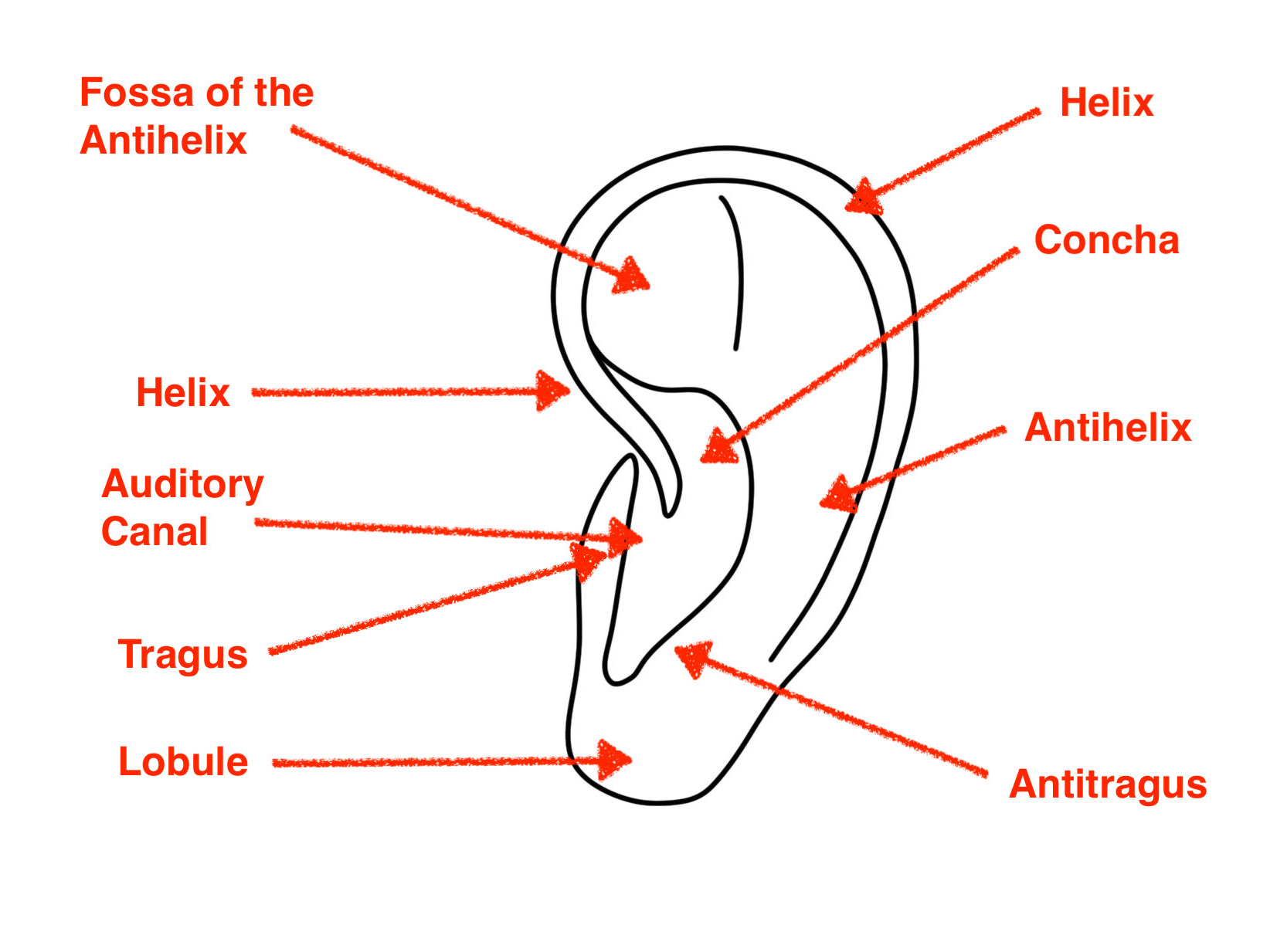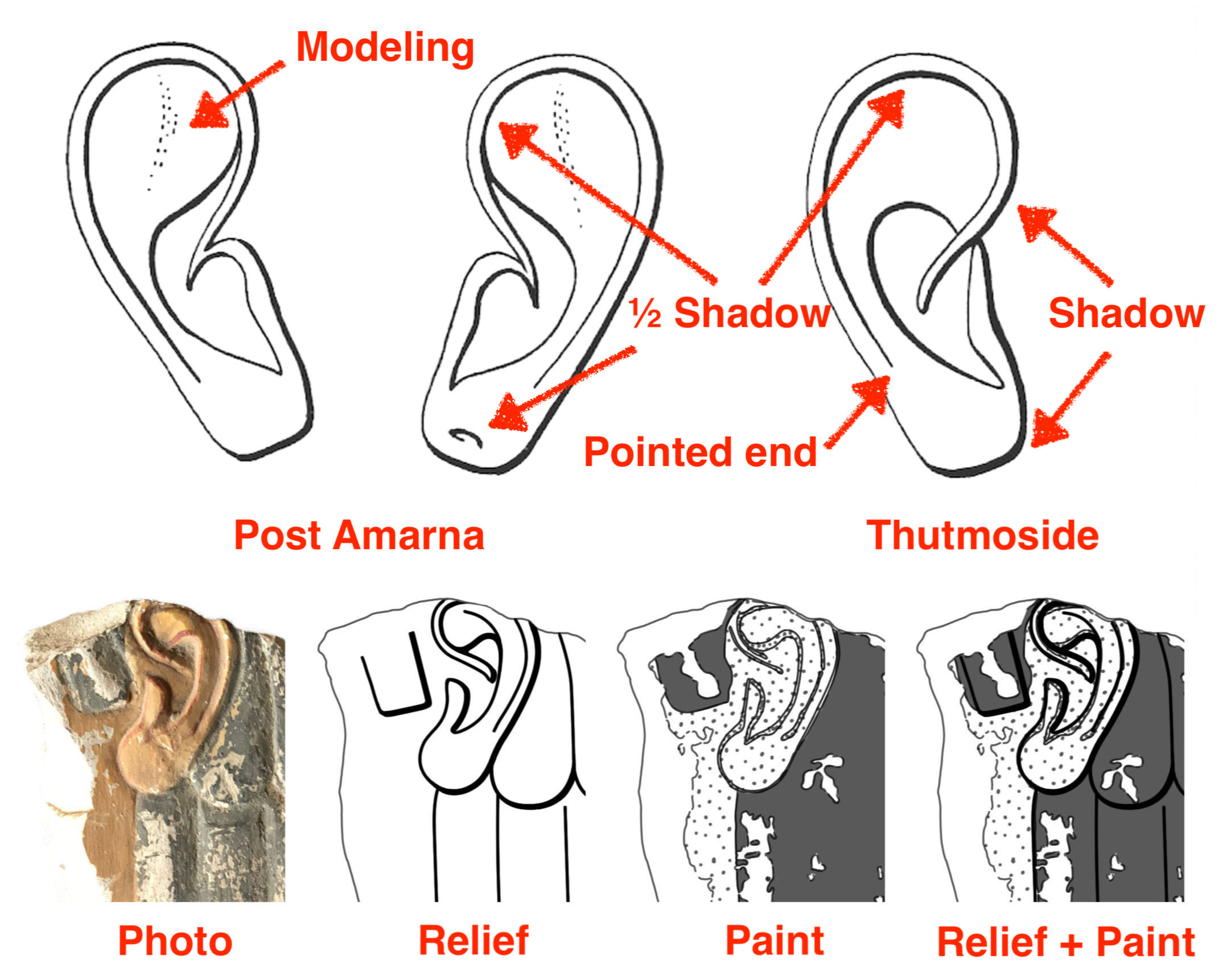Let’s talk about… Ears – stylistic attributes and visual representation guidelines based on carved and painted examples

Proper naming used by Epigraphic Survey artists and epigraphers when referring to ear parts on drawings
In this new series of tutorials, digitalEPIGRAPHY would like to draw your attention to the importance of stylistic accuracy in epigraphic documentation by focusing on the representation of a common feature: the human ear. As one of the most powerful symbols, the ear played a great role in Egyptian life. It was thought that, for example, the breath of life and death entered through the ears. As we all know, the ancient Egyptians believed in the magic realism of the depicted objects. Any image, either carved, painted or both, was to substitute for the real object or person through its representation - as a “replica” of idealized features. This confidence in the reality of depicted images required an entire system of creative conventions. To achieve maximum power and efficiency when demonstrating both the rational and the sacred character of a certain feature, an image had to reproduce the model as faithfully as possible. This aspiration to find the immaculate representation would suggest that human ears were always depicted in a similar manner. However, once we start looking at the details, we realize that there is a significant variation in how the ear appears as a 2-dimensional artistic depiction, depending on the era, technique, occasion and sometimes individual creativity. The realization and proper documentation of these general conventions and individual attributes are among the tentpoles of accurate epigraphic documentation. In the following paragraphs, we would like to point out many of these nuances through presenting a few distinct visual examples.
From photograph to drawing
Representing the ear as a 3-dimensional feature proposed just as great a challenge for the ancient artists as it does for us, who need to transfer it to paper. When carved in relief, the ear turns slightly inwards towards the face, while indicating multiple levels of depth as it proceeds from the auditory canal to the outer helix. Naturally, the epigrapher has a much more limited tool set when indicating depth on a line drawing. As you can find in the relevant chapter of the Survey’s Manual, ears are inked with two sets of shadow lines, as we use a thinner shadow brush (1/2 shadow) to draw the internal edge of the helix, distinguishing the relative shallow surface of the antihelix within the overall feature.

A typical carved ear as drawn using the sun-shadow conventions of the Chicago method (above) and the stages of drawing the feature including painted layers (TT179 below)
As you can see on the above sequence, ears, when carved, are often accompanied and elaborated by painted outlines. Digital techniques are better suited for drawing such features, as it is easier to handle the two sets of information separately. For example, in TT179 each carved fragment was drawn in Photoshop, introducing separate layers for the photographic background, the sun-shadow relief line drawing, the single-weight painted outline drawing, and finally the greyscale color coded fills for basic color indication. In its final presentation, the paint layers (outline and fill) received a certain degree of opacity allowing the relief’s black outlines to remain visible.
.jpg)
Carved ears were often generously painted using homogeneous red paint with the “leftovers” covered up later (samples from TT179 on the left and Osiris Temple Project, Abydos on the right)
.jpg)
In extreme cases, ears were carved as one homogeneous curvature shape while all the details were added in paint (sample from Osiris Temple Project, Abydos)
As the wall received its final, painted layer, the ancient artist worked with broad brush strokes adding a homogeneous coating over the entire face, including the ear. This generous overpaint could be adjusted and refined at a later phase or partially covered up by the surrounding elements, such as a crown or a wig. In our artistic representation, we should pay attention to capturing such nuances, as it may well represent the unfinished state of the ancient artwork. If a line drawing has too limited a toolset to pick up these details, color pencil might be a better tool for indicating such elements as shown above. Another interesting treatment appears when the sculptor carved only a “lump” for the ear, a raised oval shape with no details at all. It is even more obvious in these cases that the final iteration of such decorative elements intended to be painted, and, in most cases, with a great attention to detail. One should remember these well-preserved painted examples when sitting in front of colorless sandstone temple walls where painted layers are often very fragmentary or missing entirely.
Stylistic peculiarities
In the following section, digitalEPIGRAPHY collected a few examples from various sites to demonstrate the versatility in ear representation. As a rule, we’d always recommend making a few observations and look for some parallels from the given timeframe (especially when dealing with fragmentary remains) before one gets to the task of documentation. Sometimes little nuances determine the overall shape and features that appear on paper and it is the epigrapher’s responsibility to draw the right conclusions before creating his/her distilled version of the wall.
Different ear representations within the same scene
Ear representations from different eras appearing on the same monument (fragments from the 18. Dynasty Khonsu temple at Karnak
Various ear representations in the late Ramesside painted private tomb, TT65
Some well-known examples of ear representations






















0 comment(s)
Leave a comment(We'll keep your email address private)